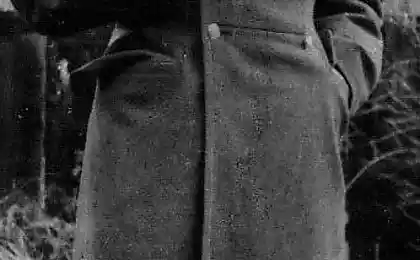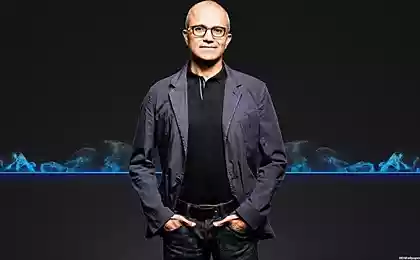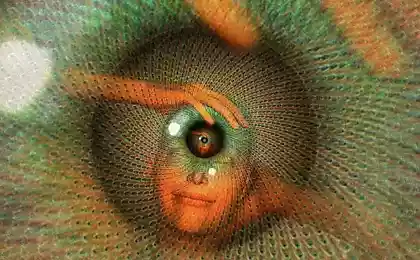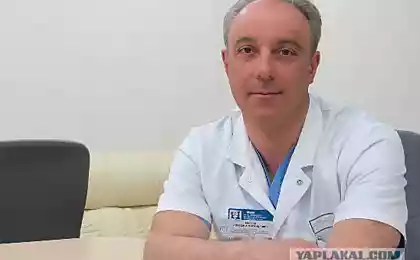2029
Cyborgs among us
While complete exoskeletons remain distant future, we would like to talk about some of the people who are already entered on the path of empowerment own body using implantable devices for those with a clear conscience can be called cyborgs.
Cyborg artist h4> Neil Harbisson - one of the youngest and media cyborgs, was born July 27, 1982 with a diagnosis of achromatopsia < / a> or, more simply, color blindness, which allows us to distinguish only shades of gray.
What implanted h4> Eyeborg - device that allows you to hear colors.
Activity h4> actively advocate for the rights of cyborgs created , where fighting for the opportunity to be considered part of the extended parts of the human body.
Cyborg scientist h4> Kevin Warwick is probably known to many here, was born on February 9, 1954, professor, author of a large klichestva .
What implanted h4> The first improvement of the organism Warwick made in 1998, which makes it one of the first cyborgs. Then he implanted transponder (RFID-tag) in the forearm. The chip allows the computer to track the movement of Warrick at the Department of Cybernetics - a computer, for example, privetstval scientist in the morning, when he came to work. Just professor could manage, doors, lights, heaters, "without lifting a finger».
Activity h4> Warrick also known as the judge and the organizer of the competition for the passage of the Turing test, he was just one of the people who found , to convince his "humanity" third of the judges passed the Turing test; He is a consultant and researcher on the project , used to control and suppress the symptoms of Parkinson's disease. The University of Reading professor led a team which is engaged in Neuroethics and dilemmas associated with it, as many of his experiments are questionable from the point of view of modern bioethics.
Cyborg-DIY h4> «I do not want to go to space in a spaceship. I want to be a spaceship » i>
What implanted h4> Circadia - rather limited embedded analogue fitness bracelets. The body is able to record figures and pass them on bluetooth on your Android smartphone. Just in it have LEDs that can be highlighted tattoo Cannon.
Activity h4> formed in 2012, working on projects such as hat, generating low voltage stimulation of the prefrontal cortex, responsible for memory and concentration; gloves with sonar detects the ultraviolet rays, Wi-FI signal, which could help blind people in the movement by using echolocation.
Cyborg artist h4> Neil Harbisson - one of the youngest and media cyborgs, was born July 27, 1982 with a diagnosis of achromatopsia < / a> or, more simply, color blindness, which allows us to distinguish only shades of gray.
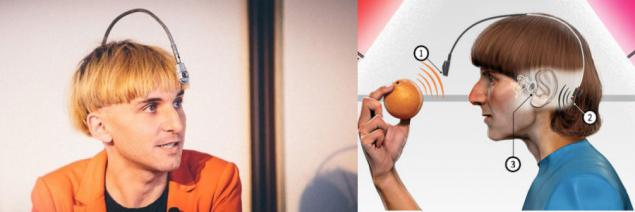
What implanted h4> Eyeborg - device that allows you to hear colors.
Consists of an antenna, which determines the color, located in front of a person in real time translates the value obtained in the sound and sends it through the skull bone to the inner ear < / a>.
Each color corresponds to a different frequency of sound picked up by one of two principles.
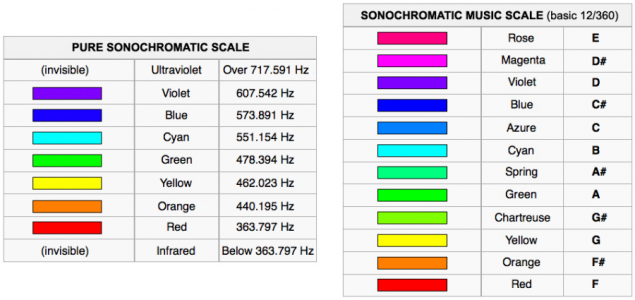
Sonochromatic Music Scale or logarithmic scale was first introduced in 2003 and allows us to distinguish the visible colors of the color wheel
Pure Sonochromatic Scale (2005) - linear scale, which allows you to "hear" invisible to the human eye colors such as infrared or ultraviolet.
The first prototype Eyeborg was established in 2003, then expanded the volume dependence of the brightness of the color. Neyroimplant was finally osseointegrated in the occipital bone in 2013. The doctor asked to remain anonymous due to the ban on such operations committee on Neuroethics.
At this point, the author allows himself to express a subjective conviction of the discipline, which in my opinion quite strongly inhibits the development cyborgization.
Activity h4> actively advocate for the rights of cyborgs created , where fighting for the opportunity to be considered part of the extended parts of the human body.
In 2004, when the photos with the antenna did not accept the document on the passport, Neil began to write letters to the passport office, claiming that the antenna is its "new body". He was supported by the attending physician, friends and colleagues, and after a few weeks of correspondence, the photo was taken.
Highly recommend to see his performance on TedTalks . Russian subtitles are available.
Cyborg scientist h4> Kevin Warwick is probably known to many here, was born on February 9, 1954, professor, author of a large klichestva .
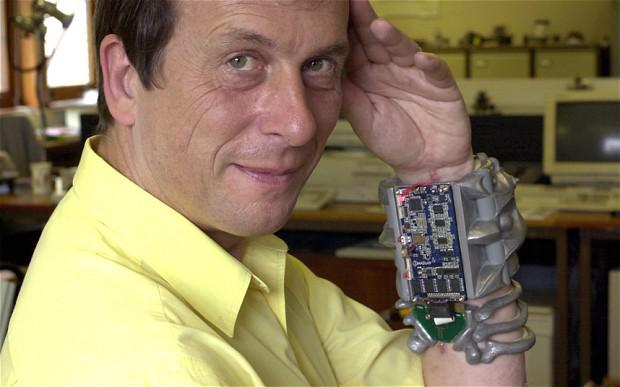
What implanted h4> The first improvement of the organism Warwick made in 1998, which makes it one of the first cyborgs. Then he implanted transponder (RFID-tag) in the forearm. The chip allows the computer to track the movement of Warrick at the Department of Cybernetics - a computer, for example, privetstval scientist in the morning, when he came to work. Just professor could manage, doors, lights, heaters, "without lifting a finger».
The second stage of the experiment Cyborg 2.0 began in 2002. The main purpose of it was to achieve feedback implanted device. In March was implanted in the median nerve, the incision was carried out just below the bend of the left hand, the whole operation lasted for a little over two hours. The experiment Warrick had the opportunity to manage a specially designed robotic arm and receive fidbek via stimulation of nerve fibers in his hand implant. This bi-directional functionality was later demonstrated by the wife of Kevin - Irena, who also went through a similar operation to implant a little simplistic - he could feel when someone touched his wife's arm.
One of the important aspects of the work of Kevin was to monitor the state of the brush after implantation of electrodes - it was feared that a direct interaction with the nervous system may cause damage or performance degradation hands. But the suggestion was not confirmed.
Activity h4> Warrick also known as the judge and the organizer of the competition for the passage of the Turing test, he was just one of the people who found , to convince his "humanity" third of the judges passed the Turing test; He is a consultant and researcher on the project , used to control and suppress the symptoms of Parkinson's disease. The University of Reading professor led a team which is engaged in Neuroethics and dilemmas associated with it, as many of his experiments are questionable from the point of view of modern bioethics.
Cyborg-DIY h4> «I do not want to go to space in a spaceship. I want to be a spaceship » i>
Tim Cannon - programmer, entrepreneur, Biohacking - was born September 11, 1979. Began his modification with more traditional piercing, and then decided that it makes no sense to waste on trifles.
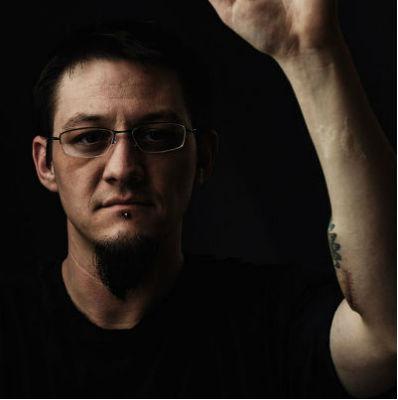
What implanted h4> Circadia - rather limited embedded analogue fitness bracelets. The body is able to record figures and pass them on bluetooth on your Android smartphone. Just in it have LEDs that can be highlighted tattoo Cannon.
By the way, the device is positioned as an open-source,
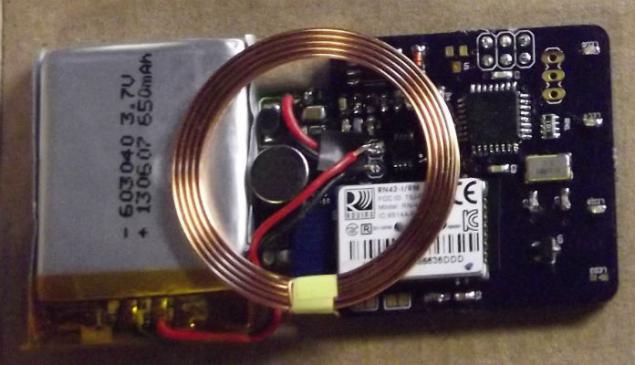
Temperature sensor, heart rate meter (data disagree whether it was included in 1.0), LEDs
Since none certified surgeon would not agree to such an operation, Tim turned for help to the tattoo parlor, found with the help of the conference participants on body modification.
"The procedure took about 10 minutes of time, it took about reached the 10 stitches, as the anesthetic used ice" - at least so say in many interviews.
At this point, the author again allow himself to remember the notorious bioethics, which provokes the spread of such basement operations have a higher probability to get a variety of complications.
Not the most accurate implantation, because, in any case, under the spoiler 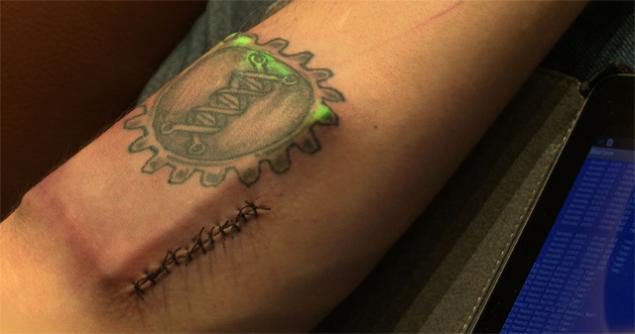
charging process, if anyone interested.
Activity h4> formed in 2012, working on projects such as hat, generating low voltage stimulation of the prefrontal cortex, responsible for memory and concentration; gloves with sonar detects the ultraviolet rays, Wi-FI signal, which could help blind people in the movement by using echolocation.
"Office" Graynhauza, located in the basement, it corresponds to the name - concrete walls, wooden beams, a dim light and a washing machine with a load of dirty laundry in the corner.
Cannon himself calls his laboratory "half cyberpunk science dungeon, half electronic and biological experimental center».
At this point, as far as I know, Circadia 1.0 extracted from the body Cannon experiment considered a success. Next version must be able to measure the pulse, blood pressure, blood sugar, and have smaller dimensions.
And finally.
If after reading this publication you suddenly inspired with the idea of implanting foreign devices in his own body, but you do not have friends brilliant surgeons, professors of cybernetics or other people who are ready to help you, there is something for you, for example, that a whale.
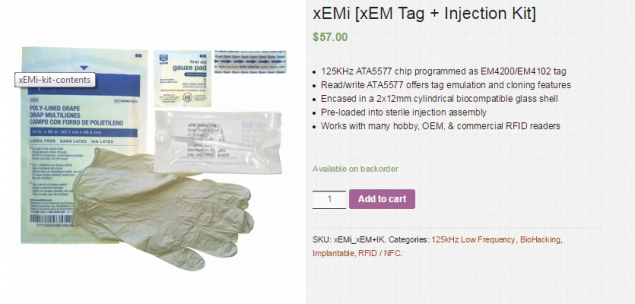
Which can be purchased here:
Source:
Cure for Ebola virus-infected macaques saved
Air Mentor tell you about the composition of air in real time









